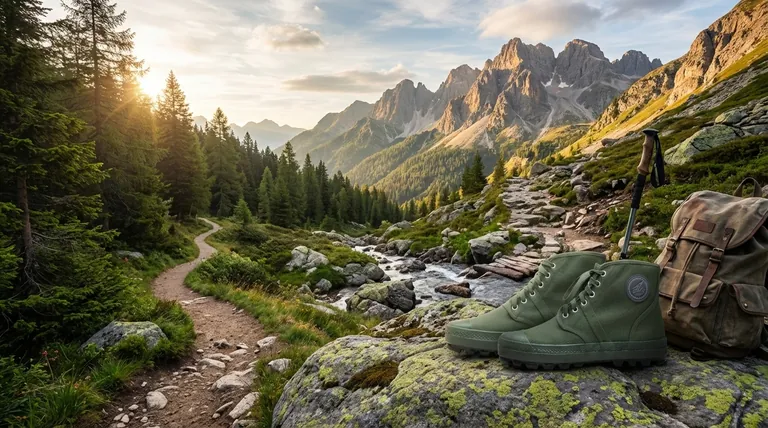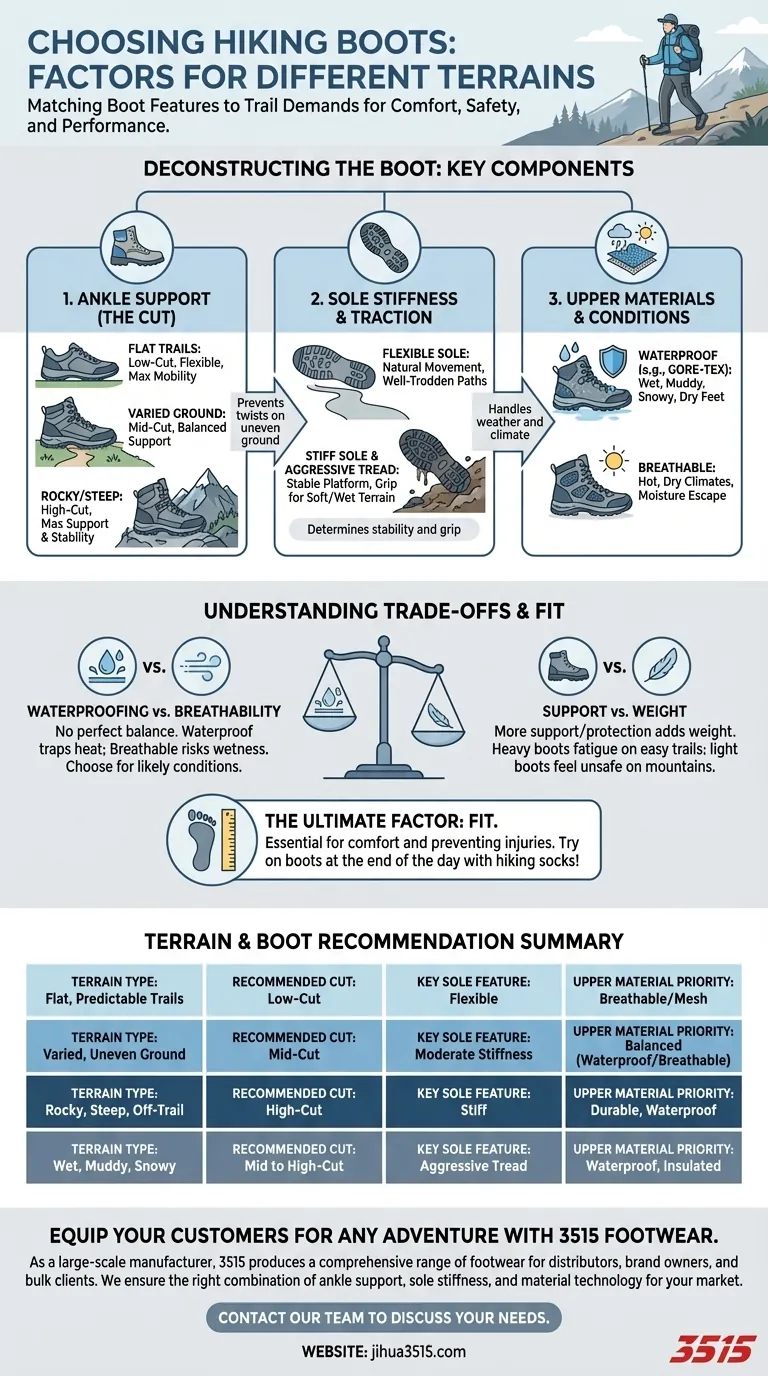The most critical factors when choosing hiking boots for different terrains are the boot's ankle support (cut), sole stiffness, and upper materials (e.g., waterproofing, breathability). These three components work together to determine a boot's suitability for a specific environment. A lightweight, flexible shoe ideal for a simple day hike would be unsafe on rugged, mountainous terrain, while a heavy-duty mountaineering boot would be needlessly fatiguing on a flat, well-maintained path.
The central principle is not to find the single "best" hiking boot, but to correctly match the boot's features to the specific demands of the terrain you plan to conquer. This alignment is the key to comfort, safety, and performance on the trail.

Deconstructing the Boot for the Terrain
To choose the right boot, you must first understand its core components and how they function. Each part of a hiking boot is engineered to solve a specific problem presented by the environment.
Ankle Support: The Role of the Cut
A boot's "cut" refers to how high it comes up the ankle. This is your primary defense against twists and sprains on uneven ground.
For flat, predictable trails, a low-cut shoe or trail runner offers maximum flexibility and minimum weight. Ankle support is not a primary concern here.
For varied or moderately uneven ground, a mid-cut boot provides a balance of flexibility and support, protecting the ankle from unexpected rocks and roots.
For rocky, steep, or off-trail terrain, a high-cut boot is essential. It provides the most significant ankle support, locking your foot in place and preventing dangerous instability.
The Foundation: Sole Stiffness and Traction
The sole of your boot is your connection to the ground. Its stiffness and tread pattern directly impact your stability and energy expenditure.
A flexible sole, found in trail runners and lightweight hikers, is ideal for well-trodden paths where your foot can move naturally.
A stiff sole is necessary for uneven or steep ground. It creates a stable platform, preventing your foot from fatiguing by wrapping around every rock and root.
The tread depth and pattern determine your grip. Deeper, more aggressive lugs are required for soft terrain like mud or sand, while specialized rubber compounds provide traction on wet rock or ice.
The Shield: Upper Materials and Conditions
The "upper" is the main body of the boot that covers your foot. The materials used here dictate how the boot handles weather and climate.
Waterproof boots, often using a membrane like Gore-Tex, are critical for wet, muddy, or snowy environments to keep your feet dry and comfortable.
Breathable boots, typically made with mesh panels, are better for hot, dry climates. They allow sweat and heat to escape, preventing blisters and discomfort.
Understanding the Trade-offs
Choosing the perfect boot always involves balancing competing features. Understanding these compromises is the mark of an informed hiker.
Waterproofing vs. Breathability
No boot is both perfectly waterproof and perfectly breathable. A waterproof membrane, while excellent at keeping water out, will always trap some heat and sweat. In a hot desert, this can be more detrimental than the risk of getting wet. You must choose based on the most likely conditions you'll face.
Support vs. Weight
Stiffness, cushioning, and high-cut ankle support add protection, but they also add significant weight. A heavy, durable boot that feels secure on a mountain scramble will feel like an anchor on a simple forest walk, causing unnecessary fatigue. Lighter is not always better, and heavier is not always safer; it's about what is appropriate for the task.
The Ultimate Factor: Fit
Even a boot with the perfect technical specifications for your terrain is worthless if it doesn't fit properly. An improper fit leads to blisters, hot spots, and pain that can ruin a hike. Trying boots on at the end of the day (when your feet are slightly swollen) with the socks you plan to hike in is a non-negotiable step.
Making the Right Choice for Your Hike
Your decision should be a direct reflection of your intended use. Use these guidelines to narrow your focus.
- If your primary focus is casual day hikes on well-maintained trails: A lightweight, low-cut hiking shoe or trail runner offers the best combination of comfort and breathability.
- If your primary focus is multi-day backpacking on varied terrain: A mid-cut boot with moderate sole stiffness provides a versatile blend of support and comfort for carrying a load.
- If your primary focus is off-trail navigation in rocky, mountainous country: A durable, high-cut boot with a stiff sole is required for maximum ankle support and stability.
- If your primary focus is hiking in consistently wet, muddy, or snowy conditions: Prioritize a waterproof boot with deep, aggressive treads, and consider insulation for winter use.
By aligning your gear with your goal, you empower yourself to move through any landscape with confidence and security.
Summary Table:
| Terrain Type | Recommended Boot Cut | Key Sole Feature | Upper Material Priority |
|---|---|---|---|
| Flat, Predictable Trails | Low-Cut | Flexible | Breathable/Mesh |
| Varied, Uneven Ground | Mid-Cut | Moderate Stiffness | Balanced (Waterproof/Breathable) |
| Rocky, Steep, Off-Trail | High-Cut | Stiff | Durable, Waterproof |
| Wet, Muddy, Snowy | Mid to High-Cut | Aggressive Tread | Waterproof, Insulated |
Ready to equip your customers with the perfect hiking boots for any adventure? As a large-scale manufacturer, 3515 produces a comprehensive range of footwear for distributors, brand owners, and bulk clients. Our production capabilities encompass all types of shoes and boots, ensuring you get the right combination of ankle support, sole stiffness, and material technology for your target market. Let us help you provide the gear that builds confidence on the trail—contact our team today to discuss your specific needs!
Visual Guide

Related Products
- Factory-Direct Wholesale Canvas Boots with High-Traction Rubber Soles
- Wholesale High-Traction Camo Boots - Custom Manufacturer for Brands
- High Performance Fire-Retardant Waterproof Safety Boots
- Wholesale Safety Footwear Manufacturer for Bulk & Custom OEM Orders
- Premium Wholesale Waterproof Safety Boots High Performance Protection for Industrial Markets
People Also Ask
- What are the advantages of rubber soles in safety boots? Unbeatable Grip & Durability
- Why are rubber soles beneficial in cold-weather boots? Superior Traction & Waterproofing
- What should be avoided when storing boots with outsoles? Protect Your Investment from Dry Rot & Decay
- What is a vulcanized sole? Discover the Secret to Superior Flexibility and Grip
- What role do slip-resistant rubber materials play in safety shoes? Ensuring Grip and Stability in Hazardous Workplaces



















